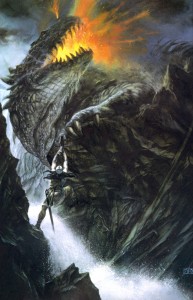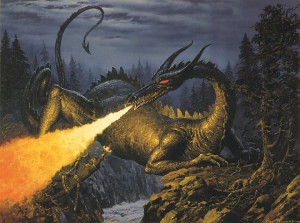
Why did Tolkien imagine only men killing dragons?
by Dr Timothy Furnish, PhD.
Dragons were very important to J.R.R. Tolkien, who acknowledged that his very first attempt at fiction-writing, when he was seven, centered around a “great green dragon.”[1]
In his seminal work Beowulf: the Monster and the Critics, Tolkien noted that in myth “there are… many heroes but very few good dragons.”[2] And in On Fairy Stories he confessed that he “desired dragons with a profound desire.”[3]
But Tolkien, despite a fascination with dragons, deployed them sparingly and judiciously in his writings. Only four were definitively named: Glaurung and Ancalagon, both in the First Age; Scatha and Smaug, both in the Third. Glaurung was the “Father of Dragons” who led the sack of the great underground Elf fortress-kingdom Nargothrond and was, later, killed by Turin Turambar, the most tragic human hero of the First Age. [4] Ancalagon “the Black” was “the mightiest of the dragon host” that fought on behalf of the Dark Lord Morgoth in the War of Wrath that ended the First Age, slain by the half-Man, half-Elf Eärendil from his flying ship Vingilot in Middle-earth’s first aerial battle. [5]
No dragons were recorded by Tolkien as being active in the Second Age, but the Third — in which The Hobbit and The Lord of the Rings take place — saw two named ones, both killed by Men. Fram, the the son of Frumgar, chieftain of the Éothéod, the ancestors of the Rohirrim who lived “in the Vales of Anduin between the Carrock and the Gladden Fields”,[6] slew the “great dragon of Ered Mithrin” (the Grey Mountains north of Mirkwood) a millennium before the War of the Ring. Fram was said, afterwards, to have been killed by Dwarves, whose treasure hoard the “long-worm” Scatha had occupied and which Fram refused to return (although he did, rather mockingly, send them a dragon-teeth necklace).
The most famous dragon of Middle-earth is almost certainly Smaug, whose demise came at the hands of Bard “the Bowman” of Dale.[7] Tolkien also stated that other dragons lived during the Third Age: an unnamed “great cold-drake” killed the Dwarf Dáin I and his son Frór in the Ered Mithrin, and “rumour of the wealth of Erebor… reached the ears of the dragons”, of whom Smaug was the greatest, but not the only, example.[8] In fact, dragons seem to have existed after the War of the Ring and, indeed, into the Fourth Age and even afterwards “in far later times, close to our own.”[9]

Elves were certainly capable of being great warriors — if not quite the superhuman athletes portrayed in Peter Jackson’s movies: Fingolfin fought Morgoth and wounded him seven times[10]; Ecthelion and Glorfindel slew Balrogs during the fall of Gondolin[11], costing each Elf his life; Gil-galad fought, along with Elendil, in personal combat against Sauron at the end of the Second Age, dying in the process (as did, of course, Elendil).[12]
And Dwarves, despite their shorter stature, were formidable warriors: Azaghâl, Lord of the First Age Dwarf kingdom Belegost, actually wounded Glaurung during the Fifth Battle, before dying[13]; and no less a Middle-earth strategist than the Lady Galadriel, in the Third Age, “looked upon the Dwarves… with the eye of a commander[14], seeing in them the finest warriors to pit against the Orcs.” But, again, no Elf or Dwarf ever killed a dragon in Tolkien’s legendarium.[15] Why is that?
Footnotes:
[1] The Letters of J.R.R. Tolkien, Humphrey Carter, ed. (New York: Houghton-Mifflin Company, 2000), p. 214.
[2] Proceedings of the British Academy, 22 (1936), p. 258.
[3] “On Fairy Stories”, in C.S. Lewis, ed., Essays Presented to Charles Williams (Grand Rapids, MI: William B. Eerdmans, 1966 [1947]).
[4] See J.R.R. Tolkien, The Children of Hurin (New York: Houghton Mifflin, 2007), pp. 176ff, 234ff.
[5] “Of the Voyage of Eärendil”, in J.R.R. Tolkien, The Silmarillion, Christopher Tolkien, ed. (Boston: Houghton Mifflin Company, 1977), especially p. 252.
[6] “Cirion and Eorl and the Friendship of Gondor and Rohan”, in J.R.R. Tolkien, Unfinished Tales of Númenor and Middle-earth, Christopher Tolkien, ed. (Boston: Houghton Mifflin Company, 1977), pp. 288ff; “Appendix A”, “Annals of the Kings and Rulers”, II, “The House of Eorl”, in J.R.R. Tolkien, The Lord of the Rings: 50th Anniversary Edition (Boston and New York: Houghton Mifflin, 2004), pp. 1064-1065 [hereafter LOTR].
[7] See J.R.R. Tolkien, The Hobbit or There and Back Again (Boston and New York: Houghton Mifflin Company, 1997 [1937], especially pp. 223-225; “Appendix A”, “Annals of the Kings and Rulers”, III, “Durin’s Folk”, LOTR, pp. 1072-1073; and “The Quest for Erebor”, Unfinished Tales, pp. 321ff.
[8] “Appendix A”, “Annals of the Kings and Rulers”, III, “Durin’s Folk”, p. 1072.
[9] Letters, p. 177.
[10] “Of the Ruin of Beleriand”, in The Silmarillion, pp. 153-154.
[11] “Of Tuor and the Fall of Gondolin”, in The Silmarillion, pp. 242-243.
[12] “Of the Rings of Power and the Third Age”, in The Silmarillion, p. 294.
[13] “Of the Fifth Battle”, in The Silmarillion, p. 193.
[14] “History of Galadriel and Celeborn”, in Unfinished Tales, p. 235.
[15] Although Dwarves “withstood [dragon] fire more hardily than either Elves or Men”, in part because “it was their custom to wear great masks in battle hideous to look upon; and those stood them in good stead against the dragons” (“Of the Fifth Battle”, p. 193). Turin actually adopted the practice of wearing such a Dwarf mask in his initial encounters with Glaurung (The Children of Hurin, p. 176).


